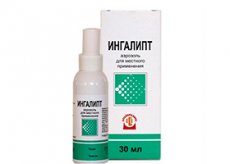Medical expert of the article
New publications
Preparations
Inhalipt
Last reviewed: 03.07.2025

All iLive content is medically reviewed or fact checked to ensure as much factual accuracy as possible.
We have strict sourcing guidelines and only link to reputable media sites, academic research institutions and, whenever possible, medically peer reviewed studies. Note that the numbers in parentheses ([1], [2], etc.) are clickable links to these studies.
If you feel that any of our content is inaccurate, out-of-date, or otherwise questionable, please select it and press Ctrl + Enter.

Ingalipt has an antimicrobial and anti-inflammatory effect.
Indications Inhalipta
It is used to eliminate pharyngitis, laryngitis, tonsillitis, aphthous or ulcerative stomatitis, and other infectious inflammatory diseases affecting the ENT organs and oral mucosa.
Release form
The product is released in the form of a spray or aerosol, in cans with a capacity of 20, 25, and also 30 or 50 ml. There is 1 such can inside the box.
Pharmacodynamics
The medicine is multicomponent and is applied locally. Soluble sulfonamides, which are part of the medicine, have an antimicrobial effect on gram-negative and -positive bacteria that provoke the development of diseases inside the oral cavity.
Thymol, as well as eucalyptus and peppermint oils, have antimycotic (against Candida fungi), antimicrobial, anti-inflammatory and mild analgesic effects.
Dosing and administration
The medication is prescribed for local irrigation of the mucous membranes in the mouth and nasopharynx.
Before using the drug, attach the sprayer to the can and then shake it. Irrigation is carried out by pressing the nozzle - the affected area is evenly treated with the drug.
During the inhalation procedure, 2-3 injections are performed. The medication should be held in the mouth for 5 minutes. Such irrigations should be performed a maximum of four times per day. The duration of the course is determined by the intensity of the therapy. Often it is 7-10 days.
The treatment regimen used for adults is also prescribed for children. Portion sizes for children are selected based on their age and with the doctor's permission.
 [ 1 ]
[ 1 ]
Use Inhalipta during pregnancy
The use of Ingalipt during lactation or pregnancy is permitted only under the supervision of the attending physician, provided that there are vital indications and taking into account the condition of the woman and the fetus/child.
Contraindications
It is contraindicated to prescribe the drug to people who are allergic to any of its components.
Side effects Inhalipta
When using the drug, side effects such as a feeling of general weakness, difficulty breathing, nausea and vomiting, as well as local symptoms (the appearance of a sore throat and burning sensation or the appearance of a “lump” in the throat) and allergic reactions (such as itching, rash and swelling at the site of contact of the drug with the skin) may develop.
People with increased sensitivity may develop Quincke's edema.
Overdose
During intoxication, a potentiation of the side effects of the drug is observed.
If symptoms of overdose occur, therapy should be stopped and the mouth should be rinsed with plain water. Symptomatic procedures should also be performed.
Shelf life
Ingalipt can be used for 2 years from the date of manufacture of the therapeutic agent.
Application for children
It is prohibited to prescribe the medicine to children under 3 years of age.
In addition, it should be taken into account that Ingalipt can cause bronchospasm in children of any age (due to the presence of eucalyptus and mint oil in its composition). Reviews rarely write about the development of such disorders, but in any case, the medication should be used, taking into account the likelihood of reflex bronchial spasm.
Therapy must be carried out exclusively under the supervision of the attending physician.
Analogues
The drug's analogues include such drugs as Kameton, Vokasept, Strepsils and Ingalipt-Vial, as well as Proposol, Geksoral, Traysils and Ingaflu. The list also includes Ajisept, Tantum Verde, Laringalipt and Rinza Lorsept.
Reviews
Ingalipt receives excellent reviews from people who used it for pharyngitis with laryngitis, as well as tonsillitis. Only occasionally there are comments that talk about the lack of effect from using the drug, as well as the appearance of side effects.
Attention!
To simplify the perception of information, this instruction for use of the drug "Inhalipt" translated and presented in a special form on the basis of the official instructions for medical use of the drug. Before use read the annotation that came directly to medicines.
Description provided for informational purposes and is not a guide to self-healing. The need for this drug, the purpose of the treatment regimen, methods and dose of the drug is determined solely by the attending physician. Self-medication is dangerous for your health.

